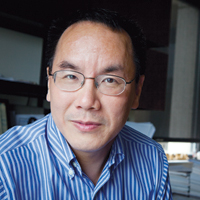Transforming Liver Care
Julie Bonn is a vibrant 24-year-old with a bright and promising future. Twelve years ago, that future hung in the balance.
“I went from being perfectly healthy to status 1A on the liver transplant list,” she says.
Status 1A is as serious as it gets. It started with what Bonn describes as mild flu-like symptoms. Within a month and without explanation, she went from active pre-teen to severely lethargic, edematous, jaundiced liver transplant candidate. When Bonn entered Cincinnati Children’s Liver Care Center and the care of William Balistreri, MD, doctors knew she would last little more than a week without a new liver. She went to the top of the transplant list and fortune smiled on her: a liver became available.
Over the next few years, Bonn battled bouts of rejection, a 50-pound weight gain from steroids, and all the attendant issues that go with receiving a transplanted organ. Even though she hasn’t had a rejection episode in nearly 10 years, Bonn still takes daily immunosuppressive medication.
She will be the first to tell you it is all worth it. But now, as a medical student with plans to become a gastroenterologist, her dream is to find a better way.
Balistreri shares that dream. By the early 1980s, he had already spent nearly two decades as a pediatric gastroenterologist and had watched too many children die from liver disease. He teamed up with surgeon Frederick Ryckman, MD, to create a place that would solve the problems of childhood liver disease, the Pediatric Liver Care Center at Cincinnati Children’s.
“It was the first in the United States and maybe the world,” says Balistreri, who remains Julie Bonn’s doctor. “We wanted to advance the field. We wanted to figure out ways to better treat liver disease, which meant better understanding its causes.”
And they have achieved much of what they set out to do. The Center is now recognized around the world for its treatment of childhood liver disease. Surgeons have performed well over 500 liver transplants, including some in neonates weighing under three pounds. NIH-funded research explores the causes of liver disease and how to improve transplant outcomes.
For Balistreri, however, the real breakthrough will come when liver transplants are no longer necessary. He recalls one of the Liver Center’s early cases, a set of identical twin boys who arrived with liver disease so advanced it seemed transplant was their only hope. Their family had already lost a child to the same disease.
Balistreri and his team drew on what they had learned in their research and avoided having to make the awful choice of which twin would get the transplant.
“We had been looking at aspects of liver metabolism,” he says, “ and we hit a home run.”
They discovered the boys were unable to produce bile acid compounds critical to liver structure and function. Once the doctors gave the children the compounds, they began to thrive and continue to do well to this day. A third brother, born later with the same disease, also was given the compounds and flourished.
The Next Challenge

|
Not all liver disease has been understood or treated so successfully, however. Liver Center researchers have now set their sights on preventing biliary atresia, the leading cause of pediatric liver transplants.
When Greg Tiao, MD, Surgical Director of liver and intestinal surgery, is not performing liver and kidney transplants, he can be found in the lab, working on an NIH-funded study of the causes of biliary atresia. Tiao’s is one of three NIH grants held by researchers at Cincinnati Children’s who are looking into the theory that biliary atresia has a viral cause.
“We suspect that a perinatal viral infection — specifically, rotavirus — targets the biliary epithelium for injury,” Tiao says. The immature fetal immune system is unable to fight the virus, leading to an inflammatory response that destroys the bile duct.
Other Cincinnati Children’s researchers looking at the link between viruses and biliary atresia are Jorge Bezerra, MD, the studies’ senior investigator, who examines how immune changes take place after viral infection. Alex Miethke, MD, focuses on whether natural killer (NK) cells might be triggers of the fetal response.
Getting at the origins of untreatable liver disease is essential, says Tiao, because growing up with a transplant comes with so many long-term complications.
“We want these kids to live to 80, or longer,” Tiao says. “But there are consequences with 80 years of immunosuppression.”
Other research at Cincinnati Children’s has begun to explore whether some transplant patients might be able to live without immunosuppression. But the ultimate goal is to make transplants a thing of the past.
“As excited as I was about establishing the liver transplant program,” says Balistreri, “I would be even more excited if we could abandon it because we’d found definitive cures.”



